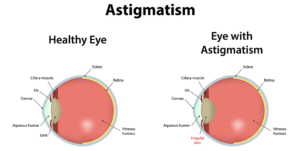Lasik is a popular surgical procedure that is used to correct vision in people with astigmatism. The surgery works by reshaping the cornea, the front portion of your eye. If you are considering Lasik surgery, it is important to know all about the complications that can arise after the procedure. In this blog post, we will discuss some of the more common complications and what you can do to minimize them.
Contents
What Is Astigmatism?

Astigmatism is a visual disorder caused by the shape of your cornea. The cornea is the clear front surface of your eye. It focuses light onto the back of your eye where you see pictures. This shape can cause astigmatism, which means that some light rays are bent or distorted. Astigmatism can be mild or severe and affects everyone differently. Agnosias are a family of vision disorders that also include astigmatism.
A common symptom of astigmatism is that objects appear blurry or distorted. You may also have difficulty reading or driving at night because the glare from oncoming headlights appears as a streak across your field of vision. In severe cases, astigmatism can cause double vision and even blindness.
There are several treatments for astigmatism, including eyeglasses, contact lenses, and surgery. Each option has its benefits and drawbacks, so it’s important to talk with your doctor about the best treatment options for you.
What Are The Symptoms of Astigmatism?
There is no one answer to this question as the symptoms of astigmatism depending on the individual. However, some of the most common symptoms include:
blurry vision
One of the most common symptoms of astigmatism is blurry vision. This can happen in both eyes and may be particularly noticeable when reading or when looking at close objects. This also means that astigmatism can make it difficult to see distant objects.
diplopia
Another common symptom of astigmatism is diplopia. This is when people have trouble seeing two objects at the same time, usually due to the blurred vision caused by astigmatism. This can make it difficult to drive or do other activities that require coordination and focus.
acuity problems
Another common symptom of astigmatism is acuity problems. This refers to the difficulty people have in seeing details and recognizing objects. As a result, people with astigmatism may have difficulty reading, driving, and doing other tasks that require precision and clarity of vision.
eye fatigue
Finally, another common symptom of astigmatism is eye fatigue. This is due to the constant strain on the eyes caused by blurry vision and difficulty seeing details. This can lead to a decreased ability to focus and get along well with other people.
Is Astigmatism After Lasik Surgery Common?

The commonness of astigmatism after Lasik surgery depends largely on the severity of astigmatism before it. Generally, most people who undergo Lasik have minimal or no astigmatism correction needed after the procedure. However, some patients may experience moderate to severe levels of astigmatism which can be more difficult to treat.
The results show that there are a variety of factors that can affect the success rate of astigmatism correction after Lasik surgery, such as the particular type of procedure and the degree of astigmatism before treatment.
Some risks of astigmatism after Lasik surgery include:
- Increased sensitivity to light and glare;
- Double vision or blurriness in the peripheral vision;
- Discomfort when wearing regular glasses; and
- Problems with night vision.
Approximately 10-15% of patients experience some degree of astigmatism after Lasik surgery, however, this does not necessarily mean that the procedure was unsuccessful.
Many patients who experience some degree of astigmatism after Lasik surgery still gain a good degree of vision correction. In addition, certain types of contact lenses can be used to correct mild astigmatism in those with moderate levels post-Lasik.
What Are The Risks of Astigmatism After Lasik Surgery?
The risks of astigmatism after Lasik surgery can depend on the patient, the type of procedure that was used, and how well their eyes heal following the surgery.
- Patients may experience a decrease in vision from pre-operative levels to post-operative levels due to an increase in astigmatism.
- Some patients also experience glare, halos, and starbursts around lights at night.
- In rare cases, these side effects can be permanent if not addressed quickly by an eye doctor.
Some of the risks can be mitigated by ensuring that the patient is properly informed before the Lasik surgery and selecting a surgeon who is experienced in working with astigmatism. It can also be beneficial to choose a laser vision correction procedure that has been specifically designed to treat mild to moderate levels of astigmatism, such as Wavefront-guided Lasik or Customized Aspheric Treatment (CAT) Laser Vision Correction.
How Can I Address Astigmatism After Lasik Surgery?

Patients need to keep their eyes healthy after Lasik surgery, especially if they have an increased risk of developing astigmatism.
- Patients should follow their eye doctor’s advice regarding follow-up visits and any recommended treatments or lifestyle changes. Regularly scheduled eye appointments are important to monitor any vision changes and protect against potential complications.
- Patients may be advised to use artificial tears, lubricating eye drops, or glasses for extra protection against astigmatism after the surgery. In some cases, a new pair of corrective lenses may be needed due to changes in refraction caused by the Lasik procedure. If necessary, contact lenses can help reduce the risk of astigmatism as well.
- It’s also important for patients to practice good hygiene when caring for their eyes after surgery. This includes regularly washing their hands and avoiding rubbing or touching their eyes unnecessarily. Additionally, wearing sunglasses with 100 percent ultraviolet (UV) protection can further reduce the risk of developing astigmatism after Lasik.
Finally, it’s important to be aware of any potential signs and symptoms of astigmatism after surgery. These may include blurred or distorted vision, increased sensitivity to light, headaches, and eye strain. If any of these signs are present, patients should contact their eye doctor right away. By following these tips, patients can help reduce their risk of developing astigmatism after Lasik surgery.
Conclusion
After having laser eye surgery, many people find that they start to experience astigmatism. This is a common complication after LASIK and can result in decreased vision. If you are experiencing astigmatism after LASIK, there are some things you can do to improve your vision and help minimize the complications that may arise from this condition. Speak with your doctor about the best way to treat your astigmatism and take action to improve your overall quality of life.
Lasik surgery is a safe 10-minute procedure to help you get rid of glasses. MantraCare offers the most advanced LASIK options. If you have any questions on LASIK surgery feel free to reach out to us at +91-9711116605.
